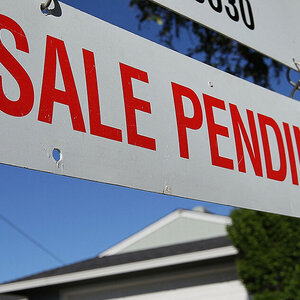The WPJ
THE WORLD PROPERTY JOURNALReal Estate Facts Not Fiction
Residential Real Estate News

Distressed Sales on the Rise Again, Representing 29% of All Homes Sold in January
Residential News » Residential Real Estate Edition | By Michael Gerrity | April 8, 2010 3:08 PM ET
According to First American CoreLogic, distressed home sales - such as short sales and real estate owned (REO) sales - accounted for 29 percent of all sales in the U.S. in January: the highest level since April 2009. The peak occurred in January 2009 when distressed sales accounted for 32 percent of all sales transactions (Figure 1). After the peak in early 2009, the distressed sale share fell to 23 percent in July, before rising again in late 2009 and continuing into 2010.
Distressed sales are non-arms length transactions such as REO or short sales. Market sales are arms-length transactions between a willing buyer and willing seller and they exclude distressed sales. Distressed sales have a very strong influence on home price trends and are an indicator of a housing market's health.
Data Highlights
- The rebound in distressed sales occurred due to increases in both the REO and short sales shares. The REO share increased to 22 percent in January 2010, up from 19 percent in December but down from a year ago when it was 27 percent (Figure 1). Short sales accounted for 8 percent of all sales in January, up from 7 percent in December and 5 percent a year ago. During the last 12 months, there were 974,000 distressed sales: 740,000 were REO sales and 234,000 were short sales.
- Among the largest 25 markets, Riverside, CA, had the largest percentage of distressed sales in January (62 percent), followed closely by Las Vegas (59 percent) and Sacramento (58 percent) (Figure 2). The top REO market was Detroit where the REO share was 48 percent, followed closely by Riverside (47 percent) and Las Vegas (45 percent). San Diego's short sale share was 19 percent in January, making it the highest ranked short sale market, followed by Sacramento (18 percent) and Oakland (16 percent). Although the top 10 markets for foreclosures are all located in Florida, only two Florida markets, Orlando and Cape Coral, made the top 10 distressed sale list. The most likely reason: Florida is a judicial state where foreclosures process through the courts and take quite a bit longer than in California, Arizona or Nevada, where non-judicial foreclosures are the norm.
- Among large markets, the biggest year-over-year declines occurred in California where the distressed sale share fell by over 10 percentage points in Oakland, San Diego, Los Angeles and Sacramento (Figure 3). The drop in the distressed share occurred generally in the most distressed markets. In markets with more moderate levels of distressed sales, the distressed share was relatively flat compared to the year ago levels. Orlando, Seattle and Houston were the only markets among the top 25 that experienced an increase in distressed sales, but the increases were small.
- Clearly there is a non-linear price response to distressed sales (Figure 4). At low shares of distress, the price discount for distressed sales relative to market sales is high as the very few properties that are distressed are highly so. Examples of low distress/high price discount markets are Tulsa and Pittsburgh. At moderate to higher levels of distress, the price discount rises with the increase in the distressed sale share as expected. However, at very high distressed sale shares the price discount is much lower, which means that the prices in the two markets (distressed and non-distressed) begin to converge into one large distressed market. Examples of very distressed markets where the gap between distressed and non-distressed prices is small include Modesto, Bakersfield and Stockton.
- Distressed sales exhibit a strong temporal negative influence on home prices (Figure 5). Home prices did not begin to decline until late 2007 in response to the rapid rise in the distressed sale share. The trough in average home prices in early 2009 occurred at exactly the same time that distressed sales had peaked.
- The average non-distressed market-sale price in January was $247,700 but the distressed average price was $161,600. The average REO price was $141,900, compared to $215,300 for short sales. The discount between market sales and distressed sales is currently about one-third and has been running at the low-to-mid 30s during the last 12 months (Figure 6).
Sign Up Free | The WPJ Weekly Newsletter
Relevant real estate news.
Actionable market intelligence.
Right to your inbox every week.
Real Estate Listings Showcase
Related News Stories
Residential Real Estate Headlines
- U.S. New-Home Sales Surge in August as Mortgage Rates Ease
- Despite Increased Foreign Buyer Activity, Miami Residential Sales Dip 11 Percent in August
- California Home Sales Enjoy Modest Uptick as Mortgage Rates Ease
- U.S. Home-Flipping Profits Sink to Lowest Level Since 2008 Financial Crisis as Costs Climb
- Why the World's Rich Are Flocking to Europe in 2025
- Federal Reserve Delivers First Rate Cut of 2025 as Mortgage Relief Proves Limited
- Homebuilder Sentiment Holds Steady in U.S. as Rate-Cut Bets Lift Outlook
- U.S. Mortgage Rates Experience Sharpest Weekly Drop in Over a Year
- U.S. Foreclosures Rise for Sixth Straight Month as Affordability Pressures Mount
- Black U.S. Homeownership Rate Falls to Two-Year Low as Job Losses Mount
- Las Vegas Home Prices Flatten as Listings Surge, Sales Slow
- Cooling Miami Housing Market Sees 16 Percent Annual Sales Drop in July
- U.S. Mortgage Delinquencies Uptick in June Amid Regional Pressures
- California, Florida Top U.S. Housing Markets Most at Risk of Downturn
- 30-Year Mortgage Drops to 6.56 Percent in Late August, Lowest Since October 2024
- Investors Maintain Elevated Role in U.S. Housing Market Despite Slight Pullback
- Pending Home Sales Show Mixed Signals as U.S. Buyers Remain Cautious
- Canadian Home Sales Extend Recovery in July
- U.S. Home Sales Rise in July as Buyers Gain More Bargaining Power
- Zombie Foreclosures Edge Up Across U.S.
- 2.6 Million Homes at Wildfire Risk Across 14 Western States in 2025
- One in Five Americans Willing to Trade Personal Safety for Home Affordability
- U.S. Home Price Growth Slows as Affordability Pressures Mount in 2025
- U.S. Mortgage Rates Dip to Four Month Low in Early August
- U.S. Mortgage Applications Rise in Late July, Breaking Four-Week Slump
- Hong Kong's Housing Market Stuck in Stalemate as Bulls and Bears Face Off
- U.S. Condo Market Struggles in 2025
- U.S. Pending Home Sales Remain Sluggish in June
- Los Angeles Area Wildfires Destroyed Nearly $52 Billion in Homes Last January
- Greater Palm Beach Area Residential Sales Slip in June Amid Growing Inventory
- Economic Resilience Lifts U.S. Housing Outlook Going Forward
- New Home Sales Stagnate as Affordability Struggles Continue in America
- U.S. Housing Market Slips in June as Prices Hit New Highs
- Florida, California Continue to Reign Supreme as America's Ultraluxury Housing Markets
- Caribbean Housing Market Evolves into Global Second-Home Hotspot
- U.S. Home Sales See Highest June Cancellation Rate on Record
- Orlando Housing Market Cools in June as Listings Slide, Sales Slow
- Private Credit Surges in 2025 as Real Estate Developers Bypass Banks
- U.S. Condo Market Suffers Sharpest Price Drops in Over a Decade as Buyers Retreat
- Rising Taxes, Insurance Costs Undermine the Stability of U.S. Homeownership
Reader Poll
Marketplace Links
This website uses cookies to improve user experience. By using our website you consent in accordance with our Cookie Policy. Read More







